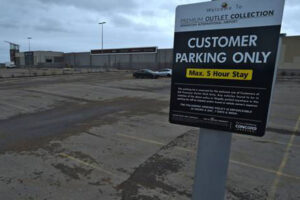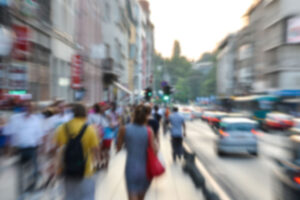By Colby Cosh
A few weeks ago, Edmonton’s council voted to remove all minimum parking requirements from real-estate developments in the city, which becomes the first in Canada to do this. Builders will, once the relevant bylaws are squared away, be free to use their own judgment in allocating parking to housing units and offices. If they choose, they can have none of it.
This was possible partly because Edmonton’s old parking requirements were absurdly grandiose. (Among its other distinctions, the city, thanks to its flagship shopping mall, is home to the world’s largest parking lot.) But it is also a triumph, in a most unexpected place, for a little band of intellectual guerrillas sometimes called the Shoupistas. They are the followers of Donald Shoup, an 81-year-old UCLA economist and urban planner who is considered the Sir Isaac Newton of parking.
Parking — boring topic, ain’t it? Shoup latched onto it as a young-ish man because he was a follower of Henry George (1839-1897), the intriguing “single tax” economic theorist of the 19th century. George favoured a tax on the unimproved value of land parcels as a way of socializing pure rent (the value earned from occupying a mere location) and encouraging development. It is a concept that many economists still like, although it is potentially difficult to apply at scale. The widely used concept of tax increment financing is one example of Georgism in practice.
Shoup started out trying to fit parking spaces into the Georgist picture, but the boring topic was so underexamined that he found himself having to build a general theory of parking. He quantified the relationship between parking and traffic, finding that people “cruising” for parking spots were more destructive than anyone had imagined, and he inspired waves of research into the hidden…
By Bob Matich
Parking structures play an important role in society and are often the first touchpoint one has with a building so, ensuring customers have a favorable experience while interacting with a parking garage becomes important in protecting revenue generated by these assets. It follows that parking structures need to be effectively maintained. By the nature of where parking garages are located and how they are used, they are subjected to the effects of harsh environmental exposure, road chemicals and daily use. One of the most critical challenges facing parking structures today is moisture penetration. Unprotected structures suffer from water-induced damage, including deterioration and corrosion caused by alkalis, salts, and acids.
The key to preventative success against detriments outlined above is utilizing a system of products designed to work together. Liquid-applied high-performance traffic membranes are a major part of such systems as they offer long-lasting protection against the most damaging conditions. While these traffic coatings are exceptionally durable to traffic, there are circumstances which can exceed the limits of even the highest performance system. This article will outline an overview of situations that should be limited or avoided, as well as periodic maintenance procedures to follow. General topics include snow removal, high heat exposure, cleanup, repair for damaged areas, repair of high wear and recoating for aesthetic purposes.
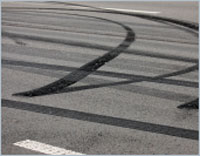
Prevention
Traffic membranes can tolerate a limited amount of extreme heat exposure. Exceeding these heat tolerances may damage or decrease the life of the system. High heat exposure may be caused by a variety of occurrences on a parking structure, including friction caused by spinning tires, non-extinguished cigarettes, or aggressive cleaning equipment. To limit exposure to high heat, it is recommended that signage be posted to limit speed, reminders to…
By Pam Strong, Lake Simcoe Region Conservation Authority
Canadian winters present many challenges for parking lot and property managers across the country, with their mix of snow, sleet, and freezing rain. The use of snowplows and the application of sand is one of the only options for colder climate areas in Canada and will generally provide the traction needed for safe conditions. In more temperate areas, however, the application of a de-icing agent is often required alongside plowing. These are typically some of the country’s more highly populated areas, making proper maintenance crucial due to the higher traffic volumes. Winter maintenance is a challenge in these areas, where temperatures often hover around the freezing mark and freeze-thaw cycles are common. However, it is in these conditions where the use of road salt (i.e. sodium chloride) has become the common, practice. As its use has become increasingly widespread over the past several years, with approximately seven million tonnes applied annually in Canada, we have also come to realize that its use comes with several significant environmental and financial consequences.
Road salt has been in use as a de-icer since the late 1940s, and it has become the most used tool in the winter maintenance toolbox. It is relatively inexpensive, generally easy to access, easy to store and use, and it is highly effective at melting snow and ice, at temperatures down to -9° Celsius. These characteristics have led to its widespread use for road maintenance, and for private residences and parking lots of all types. In 2004, Environment Canada introduced a Code of Practice for the Environmental Management of Road Salts, for use by road maintenance agencies. Since that time, these agencies have been making efforts to refine their winter maintenance practices and reduce the amount of salt…
By Kristen Locke, CAPP
Parking technology has transformed significantly in recent years. In the parking and mobility industry, there has been a surge of new enhancements to the traditional options for technology including frictionless hardware, efficient enforcement systems, smart sensors and wayfinding, and mobile parking platforms. Leaders throughout the industry now have the opportunity to innovate with their systems more than ever, and they also have the option to customize their operation with the right solution to fit their unique operational needs.
While this explosion of new technologies can come with many exciting opportunities for the municipalities, universities, private operators, and others looking to start managing increasing parking demand, adopting new technologies also comes with a lot of pressure. Not every solution is right for every organization. How does one choose between all of the options available? And what solution (or combination thereof) will provide the best experience for your users, while meeting all of your organization’s goals?
Each organization faces different challenges, serves a unique audience, and has different long-term goals. It is important to refocus and have a comprehensive understanding of what your organization is looking to accomplish before ultimately selecting the new technology that is right for you.
I’m in the market to start using a new technology solution. What do I need to know?
Prior to purchasing and implementing a new parking and mobility technology or platform for your organization, it is critical to ask the right questions. These questions should address your current needs, as well as future goals.
Some of these questions include:
• What are the biggest challenges our organization faces today and what solution will best help to alleviate them?
• What is most important to our users?
Eyad Abu Rish | The Tom Arnold Scholarship in Parking Industry Advancement at York University
 Engineering can impact the face of the parking industry and reshape our parking experience, especially with autonomous vehicles becoming a norm in the close future. With this technology rising, we can create more parking spaces and automate the process.
Engineering can impact the face of the parking industry and reshape our parking experience, especially with autonomous vehicles becoming a norm in the close future. With this technology rising, we can create more parking spaces and automate the process.
There are various ways engineering is changing the industry, as quoted by York university’s transportation-engineering professor Kevin Gingerich: “Many jurisdictions are beginning to question the need for minimum parking requirements as dense cities become increasingly multimodal and shift away from the traditional automotive emphasis. Autonomous vehicles and transportation network companies (TNC) such as Lyft and Uber will lead to further changes in this demand and require transportation professionals to rethink our current parking policies and solutions”. I will be focusing on autonomous vehicles in this article as the latter is self-explanatory.
Imagine you are arriving late to the mall just before the holidays as you are picking up a gift, 20 mins before closing time. Soon, you will be able to instruct your car to find a parking space and get off shopping. Meanwhile, your car would communicate with the parking structure to find an empty parking spot; in response, your car will park in the spot and notify you of the location code.
Here in Toronto, parking can be very limited. Some studies, such as the ones done at the University of Toronto, have proposed a grid like system for parking where cars would park in a congested-matrix form. This means that cars can be placed in front and beside each other without any spaces. This would be limited to only autonomous vehicles, which would be able to communicate with one another and thus make room for…
By Eric Borromeo
Ctrl-Z Team 5831 is a FIRST LEGO League (FLL) robotics team from Bayview Glen School in Toronto. FLL is a STEM programme with over 38,000 teams from 100 countries competing across three aspects: innovative solution, autonomous robot and core values.
For the 2019-2020 FLL season, teams were challenged to identify a problem related to buildings or public places in the community and create an innovative solution for such problem. Prior years’ themes have related to space travel, waste management, climate change, food safety and other pertinent topics.
Ctrl-Z’s Project
The problem we are addressing is accessibility. People without accessible parking permits are using designated spots illegally and blocking access to those who require them. This prevents people with disabilities and many seniors from leaving their homes, leading to isolation and immobility. We need a way to ensure accessible parking is available to those who need it.
Ctrl‐Z’s Solution
Our solution, the SPOT SAVER, will ensure access to parking that will lead to greater levels of physical activity and interaction with others, resulting in improved mental health and longevity.
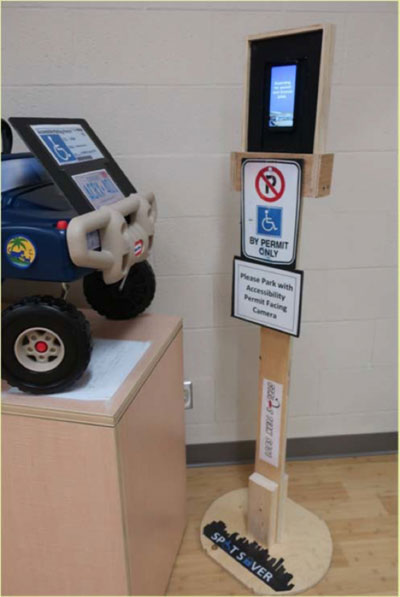
Prototype: The vehicle displaying the permits is the Lego component.
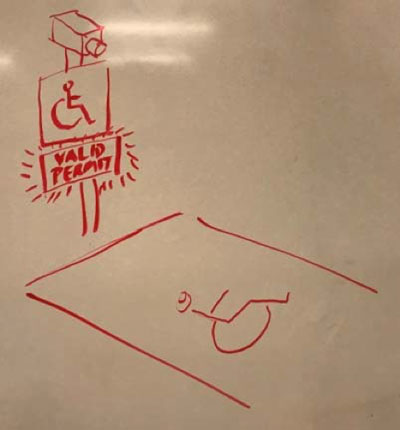
Preliminary Sketch of Prototype
How It Works
The SPOT SAVER consists of an optical character recognition system designed to ensure that special needs persons and seniors can have much needed access to accessible parking spaces in various community spaces across the city.
There are two main parts: a camera located on the top of a pole in front of the accessible parking spot which detects the presence of an accessible parking permit on the dash of a parked car. If detected, a message saying, “Valid permit detected” with a green light will appear on a display screen below…
By Michael Back
Contactless infrastructure has been in place for years but until now, consumers have not embraced this technology on a broad scale. As a result, parking operations have offered it inconsistently across the board. The tides are changing – but will it be a tsunami?
The climate around coronavirus has drawn particularly close attention to the cleanliness and safety associated with both cash and the high-touch payment technology that we use every day — from ATMs to retail pin pads to parking infrastructure. The new consumer hypersensitivity around previously simple conveniences of modern-day life will need to be re-examined post COVID-19.
Let’s start by considering just how unhygienic — and as a direct result — unsafe cash and high-touch payment technology happens to be:
We have known for years that banknotes harbour the perfect environment for microbes to settle. Past studies have shown that bills carry more than 3,000 types of bacteria including E. coli, Salmonella, and Staphylococcus aureus. But as the world comes together to stop the spread of COVID-19, what’s new is that governments are starting to undertake strong measures to alleviate coronavirus transmission via cash handling — China is disinfecting and locking away used banknotes, while the Bank of Korea is heating banknotes, and in some cases, burning the bills. In addition, the Bank of Korea will no longer handle the exchange of coins and banknotes that have been introduced from abroad.
Another powerful recommendation in the move away from cash comes from the World Health Organization, which has urged the population to avoid cash and to use contactless payments to reduce the risk of transmission of COVID-19. In an April 2020 study, The Lancet Microbe looked at how long the coronavirus lasts on various surfaces. Among their discoveries was that the…
By Marc-Antoine Ducas
Moving to and from the office can be a challenge for a lot of employees and it can be a headache for employers. Actual mobility solutions are not always optimal and some employees have to use their car. When office parking is saturated, companies have to offer better commuting options or face the prospect that valued employees will look at other job opportunities that make their life easier.
The solution is to encourage employee carpooling and there are numerous strategies that many companies already use to great effect. All successful employee carpooling programs have one element in common – make carpooling as easy and convenient as possible to position it as a viable alternative to commuting in a single-occupancy vehicle.
When coordinating carpools for large groups, obstacles such as differing work schedules, unpredictable weather and accounting for last-minute changes are inevitable, but the overall benefits do outweigh the challenges. As 100% of carpooling drivers have to park when they get to their destination, we realize that parking is the key incentive to change their behaviour. Travel time and use of high occupancy vehicle (HOV) lanes also interest people in carpooling.
Netlift works with companies to determine needs and constraints in relation to employee mobility. Our goal is to provide a sustainable mobility solution while optimizing parking facility usage.
Employees install the Netlift app and enter their commute route. Parking access, ride payment, employee contributions and reimbursements to drivers are all handled through the app, taking the hassle out of commuting and making the most of current parking facilities.
But when an organization runs out of parking spots then that means building new parking lots or hiring shuttle services, an important cost. Netlift’s ongoing objective is to optimize available parking by putting more people per car.
By Matt Jobin
The Coronavirus crisis has thrown our lives into chaos, and it’s changing the way that we, as parking professionals, think about parking.
The public health crisis will eventually pass, but even as it does, it will be important that cities, private parking owners, and organizations with parking assets work with their parking consultants learn from this crisis. This pandemic provides a stark reminder that people are susceptible to illness, and we should strive to find ways to minimize the risk.
As a parking facility designer, I’ve always considered safety to be one of the most important design elements. Until recently, though, these types of healthcare issues weren’t part of the equation. But as the Coronavirus crisis has shown, it should be. The parking process exposes people to many common “touch-points”, forcing drivers to touch surfaces that others (often many others) have already touched. This is how illness spreads, and as we are learning during this pandemic, viruses can live for several days on surfaces. This is an important issue, not just now, but in normal times too. We are constantly coming into contact with flu and cold viruses, as well as many types of bacteria. As such, cities and parking owners and their design teams need to be aware of where potential risks exist within parkades and how to mitigate them.
So, the question is, how can we reduce the risk of viruses being introduced to high-use surfaces within parkades?
Start with Technology
Technology can play an important role. There are a number of technologies already in use that can reduce touch-points. Perhaps the most common, and useful, are frictionless parking suites that use LPR to recognize a vehicle as it enters and exits, and automatically bills the driver’s credit card or associates the parking episode with a permit. These suites…
By David Burr
“Nobody goes there anymore; it’s too crowded.” – Yogi Berra
The traditional behavior of automobile drivers heading into the city center and finding parking has led to an untenable level of traffic and congestion in many cities. Urban roadways are at or beyond capacity and, as cities become denser and populations increase, this problem will only get worse. Anyone who has driven in a dense urban environment is aware of this, yet still they come, despite knowing the headaches and the hassles of driving and parking in these urban areas. The solution, of course, is not fewer people, but fewer vehicles.
To achieve this decreased use of individual cars within city centers, cities need to ask themselves what motivates drivers to continue this behavior, and then tailor alternative transportation solutions that accommodate these needs when possible. By developing programs and policies that encourage pedestrianism and the use of alternative transportation, as well as accommodating bicycle and scooter traffic as supplementary forms of transit, cities can begin to get closer to reducing urban vehicle traffic while not impairing use and access, but rather enhancing it.
A natural consequence of striving for this solution is that transportation, particularly as people move in and out of metropolitan corridors on daily commutes, is becoming more intermodal. In order to operate efficiently and accommodate the needs of people traveling into and around dense urban areas, and back out to less dense suburban areas, transportation systems also need to offer options and fully leverage the various forms of existing infrastructure and high density transit options available to them.
To drive adoption and increase the use of these various forms of transport, it is important to understand them functioning not individually, but rather as separate links in a greater transportation “chain”. A chain…


